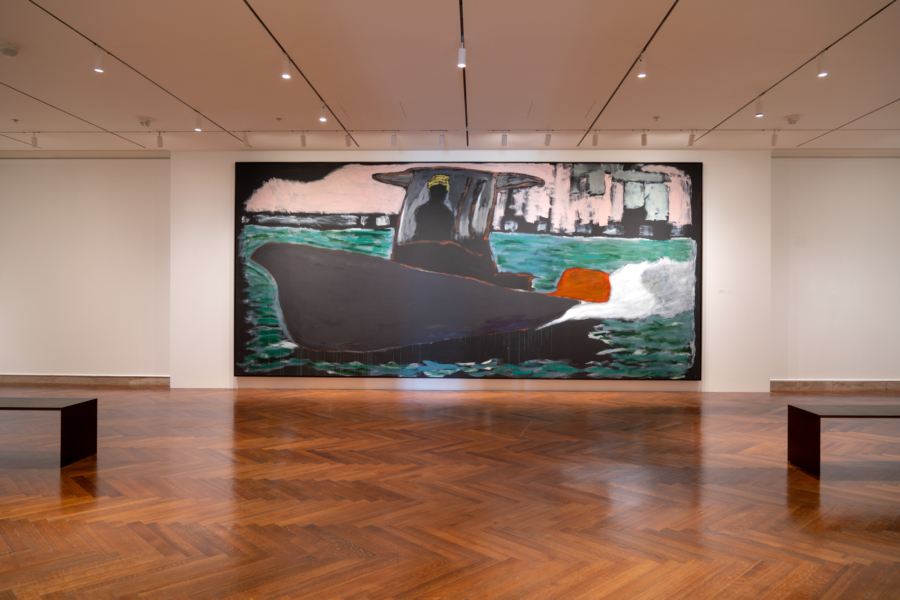October 12, 2023
Download as PDF
View on The Boston Globe

Installation image, Reggie Burrows Hodges, “Turning a Big Ship,” Addison Gallery of American Art.Addison Gallery of American Art
Reggie Burrows Hodges’s ‘Turning a Big Ship’ brings overlooked tales to the surface
ANDOVER — In the work of Reggie Burrows Hodges, all comes from darkness. The Maine-based painter now having his first museum exhibition at the Addison Gallery in Andover, starts by coating every canvas with a deep, flat back; it’s the foundation for every one of his works, as though every figure and object has first to escape shadow just to be.
There’s no end to metaphor to be applied here. Hodges, born in 1965 in the Compton district of Los Angeles, the same year as the race riots in neighboring Watts, has often painted from the memory fog of his childhood, crafting indistinct scenes shrouded by the haze of incomplete recall. At their heart, frequently, are people limned by the artist’s bright gestural strokes, but at their core a blank, dark void, as though abruptly clipped and removed from the world.
“Turning a Big Ship,” his exhibition at the Addison Gallery, extends the practice, and the metaphor. In more than 20 works, Hodges riffs on the Addison’s in-house collection of historical marine art (a loose companion show here, “Sea Change,” further muddies the waters with selections from the Addison’s formidable Modern and contemporary holdings, where complexity reigns). In “Hodges’s Chromium Dip,” 2022, a huge canvas in the exhibition’s main space, the dark prow of a boat surges into the foreground, captained by a figure seen only in silhouette. Compositionally, emptiness dominates; the aquamarine of the water and the pale pink of land are confined to the margins, only as present as the void permits them to be.
It’s not hard to read the piece, and the show, as a response to marine painting’s blithe celebration of a young nation’s adventurous, seafaring spirit. That’s not the half of it. The sea brought settlers, then trade, and with it, enslavement and its harrowing fallout, still so present even now. The big ship to turn, it seems, remains America itself, forever on a tack and jibe of two steps forward, one back.
The exhibition includes a quote from the poet Derek Walcott: “The sea is history.” Hodges also visually quotes totemic American Modern painters like Mark Rothko, with his oppressive fogs of color, or the bare figurative aestherics of Milton Avery. But his signature technique — scenes built from black ground, pulled from the shadows — to me suggest an alternative history kept from the light. Hodges, the Addison’s inaugural Bartlett H. Hayes Jr. Prize winner, doesn’t deny himself the simple pleasures of marine form. Pieces like “Sloop: New Sun,” 2022, a pale triangle of billowing sail against dark water, or “Sloop: Inn Bound,” 2022, more heavily impastoed in pink and green, indulge dynamic painterly appetite to capture the waft of sail in the breeze and the roll of current and tide.
Hodges’s technique is itself a reinvention, a perceptual pivot point that throws the familiar off kilter: The black sails of “Sloop: Post Script,” 2022, and “ Sloop: Greens Passing,” 2022, feel like photo-negatives, a reversal of reality. Whose reality, you might ask? Good question. A series of portraits of ship captains draws you deeper. Conventionally framed — shoulders-up, like any Very Important Person — their features vanish into dark obscurity. “See Captain: Nella,” 2023, with its shards of cool blue and earthy brown, seems almost to be fracturing before your eyes. “See Captain: Mary,” 2022, with its mound of soft pink coat serving as a pedestal for a barely formed face topped with a distinctly Washingtonian hat, feels almost like an inside joke — off-the-rack significance, dissolving in the flood of competing memory.
These works imply what I think the exhibition intends: to clarify the subjectivity of what we’ve long taken to be collective memory, and what gets lost in the wash. “Salt Chuck Layer,” 2022, a big canvas of a small figure apparently flung from the deck of a sailboat, aloft for a moment before plunging below the waves, is as blunt, I think, as Hodges gets. I couldn’t look at the scene — spare, simple, a fog of blues and grays — without thinking of the Middle Passage, and the sick and old thrown overboard on the way to the slave markets on the American side. There’s historical precedent for such scenes, but “Salt Chuck Layer” feels elemental, succinct in the implied horror of a lone body consumed by the endless sea.
This is not the narrative found in heroic portrayals of American seafaring — or in America, period — and Hodges offers a powerful counterpoint right up front. A marble fountain with a classical nude female figure centers the Addison’s entry rotunda; hung right beside it is Hodges’s “Sloop: Mainland Revival,” 2022, of a dark figure hunched over a skiff marooned on a tidal flat, the earth and sky dissolving into each other in a mist of soft color and indistinct form. Against something so solid, and sure, Hodges proposes a scene more true to the America he knows: a place still fluid and uncertain, struggling to fully be.
REGGIE BURROWS HODGES: TURNING A BIG SHIP
Through Dec. 31. Addison Gallery of American Art at Philips Academy, 3 Chapel Ave., Andover. 978-749-4015, www.addisongallery.org



